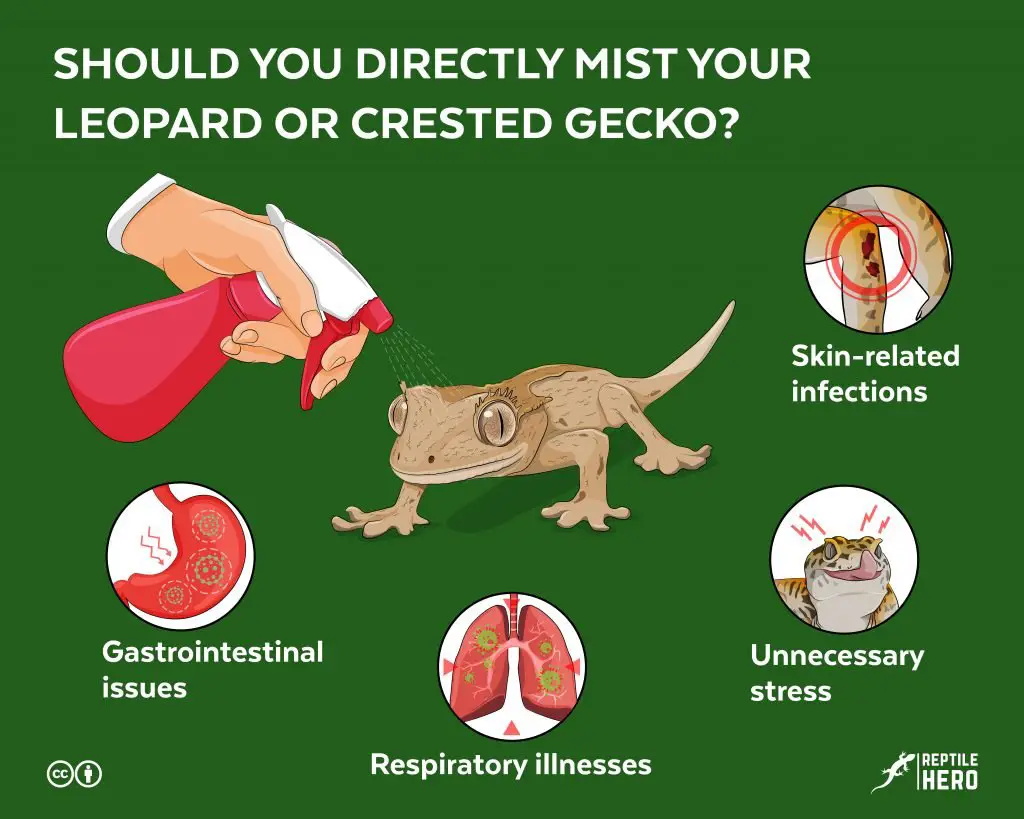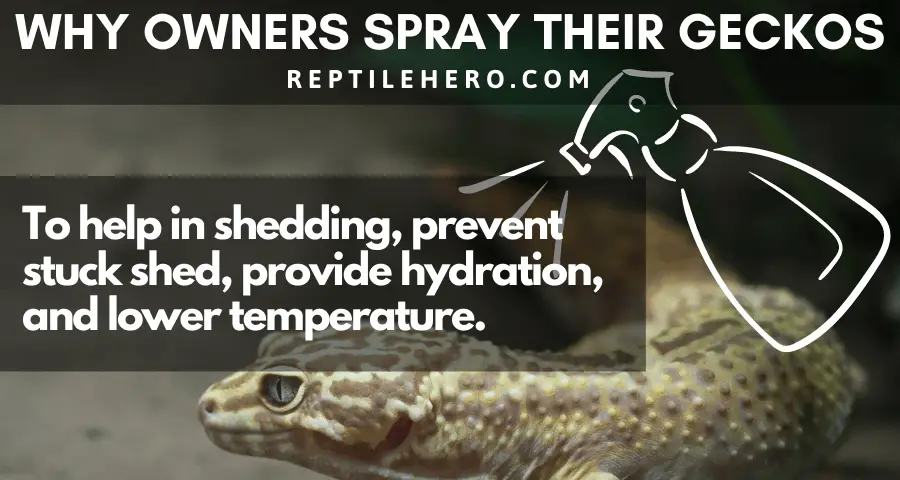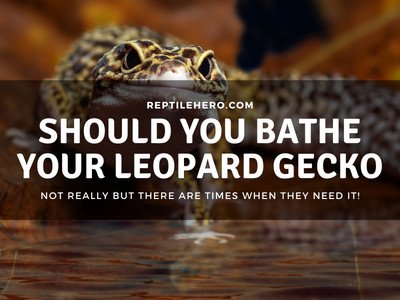Should You Directly Mist Your Leopard Or Crested Gecko? [4 Reasons and 4 Dangers]
If you ever thought that spraying your gecko is a great idea, you are in the right place! Hopefully, you will change your mind. However, please avoid it if you do not want to trigger stomach aches in your reptile (or even worse).
Misting leopard and crested gecko is unsafe practice because of possible:
- gastrointestinal issues
- respiratory illnesses
- skin-related infections
- unnecessary stress
Nevertheless, many leopard and crested gecko owners nowadays still recommend direct spraying of water to geckos as they have noticed it can 1) help in shedding, 2) prevent stuck shed, 3) provide hydration, and 4) lower temperature.
To know why others mist (or do not mist) their geckos, stay with us and keep scrolling!
The 4 Reasons Why Owners Spray Their Geckos
On the contrary, if the (bizarre) idea of directly misting your gecko has never crossed your mind, this could be the perfect time to know why some gecko owners perform this somewhat intriguing practice to their reptiles.
Four of the most specific points are as follows:
#1. Help in Shedding
Owners have observed that baby and juvenile geckos may not necessarily enter their humid hides or moist boxes during shedding. To make up for this challenging behavior, owners have found that daily direct misting can help babies and juveniles in their frequent shedding.

#2. Prevent a Stuck Shed
Owners of adult geckos have discovered that directly spraying their reptiles twice a week could benefit their pet. Especially when done prior to shedding-proper, it could be an effective way to avoid dealing with complications like partial and stuck shedding issues.
#3. Provide Hydration
It is a must to add humid hides and water bowls in the enclosure of leos and cresties. However, some owners living in drier regions found these to be insufficient. As a compromise, they learned that direct and occasional misting may supply additional humidity that could provide hydration.
#4. Lower Body Temperature
Not every gecko owner can afford the added expense of expensive methods to cool down a warm tank during summer. Some have resorted to manual and direct spraying on their geckos when temperatures hit all-time high; they have discovered that it could be a no-cost alternative to address the problem.

What Could Go Wrong?
Despite direct spraying a gecko can have some benefits on special occasions, it is something that we still do not recommend. Indeed, the risk might be bigger than the benefits.
Directly spraying water to a leopard or crested gecko can be detrimental to its health because this practice may cause several health-related issues like:
- gastrointestinal issues
- respiratory illnesses
- skin-related infections
- unnecessary stress
Most owners believe (and you might have been convinced) that direct misting can be rather beneficial than harmful to their geckos. However, they might have failed to consider that the action (and an excess of it) does have adverse and severe health-related effects on the reptile.
Gastrointestinal Issues
Frequently, when talking about misting and high humidity over an extended period, what comes to your mind would be gecko illnesses related to the respiratory tract and skin. Also, you might be expecting some mold talks here and mildew talks there because they love the high humidity of overly misted enclosures.
However, a gecko may experience fungal gastrointestinal tract issues when directly sprayed with water. The fungi responsible for these conditions are (you guessed that right) mold and mildew. While gastrointestinal tract problems are typically caused by parasites, both fungi can also cause such discomforts with signs like:
- diarrhea
- lack of appetite
- lethargy
- loss of weight
- weakness
Respiratory Illnesses
Occasional direct misting is a one-way express ticket for your leopard or crested gecko to acquire respiratory illnesses. This is because the action can be likened to the prolonged high level of humidity in the tank.
One of the many lung infections that can sicken your gecko after direct misting is pneumonia. Although you might not have done it, you may be better off knowing its signs that could be manifested by an infected gecko, such as:
- breathing with an open mouth
- difficulty when breathing
- lethargy
- loss of appetite
- loss of weight
- unusual discharges from the mouth and/or nose
- unusual sounds (wheezes and crackles) while breathing
Skin-related Infections
Skin-related infections may not be as widespread of information when talking about the dangers of spraying water at your leopard or crested gecko. However, these infections are just as serious of a matter that you should be aware of when you think of doing it to your reptile.
Bacterial dermatitis is one of the many skin-related infections that your gecko may acquire because of direct misting. Often, this skin condition is called in other names like blistering disease, rotting of the skin, or septicemic cutaneous ulcerative disease. Even if you have not misted your gecko directly, it is worth knowing of its signs like:
- small red lesions or blister-like ulcers during the early stage
- open wounds from ruptured blisters in later stages
- large and deep wounds in extreme cases
Unnecessary Stress
Imagine having to run your way to a shade while soaking wet under heavy rain with no umbrella at hand. Is the situation not stressful enough for you? Certainly, it should be.
Similarly, directly misting your gecko can cause unnecessary stress. While the practice can be just one of the many reasons your gecko may feel stressed, it is handy to know its signs (considering that no other problems are causing these):
- hiding or burying
- eyes closing
- glass surfing
- tail waving
- tongue licking
- vocalizing

What Should You Do?
Owners must address the issues related to shedding, hydration, and temperature by misting the enclosure—not their geckos. The practice of direct spraying water to leopard and crested geckos is gaining popularity. However, it does not mean that when many people do it, the action is appropriate.
When both geckos are in the wild, they apparently do not experience their preferred humidity (and temperature) demands. Often, they experience fluctuations because of heavy rains and extreme drought. So, I would not freak out too much in keeping perfect and stable levels for each parameter. Instead, you should allow occasional to rare variations of the two.
After all, too wet is utterly as bad as too dry, vice versa. Just see to it that your gecko healthily sheds as it is an equally good indicator that nothing is to worry about. You can check these three tips to maintain a healthy shed:
Tip #1 – Add High-Quality Measuring Devices
Maintaining a healthy shed in leopard and crested geckos entails being able to read the enclosure’s humidity and temperature as accurately as possible.
You may say that I am stating the obvious (which honestly is), but several owners fail to equip their gecko’s enclosure with high-quality measuring devices like thermometer and hygrometer. A number of these tools are sold at low prices or as a bundle in generic starter kits. However, often, they do not correctly work as expected.
What I can suggest is that you are better off investing in digital two-in-one models rather than analog ones to avoid inconsistent results from unreliable readings. One of the items you can check out is this product on Amazon.
Tip #2 – Perform Regular Misting
Keeping leopard and crested geckos to shed dead skin healthily requires automatic or manual misting of the enclosure.
Again, this tip should be apparent that every gecko owner must be responsible enough to know. However, everyone can sometimes forget that a friendly reminder of the importance of regular misting is needed. You can do it automatically or manually in the tank, not on your gecko.
- Automatic. When you are busy doing it manually or are eager to invest in an expensive automated misting system, you can get this product on Amazon to do the spraying on your behalf. This may also come in handy when you head out on vacation.
- Manual. If budget is a problem or an automatic mister is not your priority, you can make use of any spraying bottles. As long as it is clean, it does not really matter which one you would use. Just be careful and always use the appropriate water—purified water.
Use The Appropriate Water
When automatically or manually misting the tank, you cannot just use any water. Some may suggest that you use tap water because of the retained minerals. However, you may not necessarily know the complete composition of your tap water. This could bring harm to your reptile as there could be harmful chemicals present.
So, it is best to avoid tap water and safest to use only purified water when misting. Also called demineralized water, this water has undergone deionization, distillation, reverse osmosis, or similar processes for safe use.
Tip #3 – Reevaluate The Enclosure
Leopard and crested geckos that consistently shed off dead skin healthily are affected by the overall condition of their enclosure.
You must sustain your gecko with a conducive tank for its shedding (and general health). Instead of directly misting your reptile with water to aid in shedding, prevent stuck shed, provide hydration, or cool down, you have to reevaluate its enclosure.
Five factors must be evaluated to provide a comfortable gecko enclosure:
- The general conditions in the house. Since the tank is located inside a room in your home, the room’s temperature and humidity play an essential role when keeping these parameters stable inside the enclosure.
- The type of enclosure. Different enclosures hold temperature and humidity differently, and they may require specific care and attention. So, you are expected to deal with acrylic, glass, and wooden vivariums accordingly.
- The type of substrate. The type of substrate also affects how temperature and humidity are stabilized in the tank. Not only that but some substrates (like loose ones) are strictly prohibited for use in gecko tanks.
- The kind of vivarium plants. Adding live or fake plants or woods inside the tank may also affect how temperature and humidity fluctuate inside the enclosure. Especially real plants, they can either retain or absorb moisture from the tank’s air.
- The accessories in the tank. Keeping your gecko hydrated is as easy as giving water bowls. Maintaining the required humidity and lowering the temperature can be solved by supplying moist hides. However, some items may be better in increasing or decreasing temperature and moisture.
Trigger Warning! The video could offend you as you might find the title contradicting what the gecko is doing. However, the owner might be doing it for any reason (or as stated above) and may not mean to intentionally harm the gecko.
Takeaways
Many gecko owners recommend directly spraying water on leopard and crested geckos. They claimed to have observed that doing so can 1) help in shedding, 2) prevent stuck shed, 3) provide hydration, and 4) cool down the gecko.
While several owners may be convinced by the benefits of this practice, it is equally vital to be aware of the health-related dangers it poses: 1) gastrointestinal issues, 2) respiratory illnesses, 3) skin-related infections, and 4) stress.
Directly misting or spraying leopard and crested geckos with water is not a solution when addressing shedding, hydration, and temperature problems—misting or spraying the tank is.

![Taking Care of Geckos During Power Outages [Final Guide]](https://www.reptilehero.com/wp-content/uploads/2021/04/Gecko-Care-Power-Outage-768x614.jpg)

![How to Choose a Halogen Lamp for Your Leopard Gecko [In-Depth]](https://www.reptilehero.com/wp-content/uploads/2021/07/word-image.jpg)
![Do Geckos Drink Milk? [Think it Twice]](https://www.reptilehero.com/wp-content/uploads/2021/07/Does-Gecko-Drink-Milk-Infographic-768x614.jpg)


